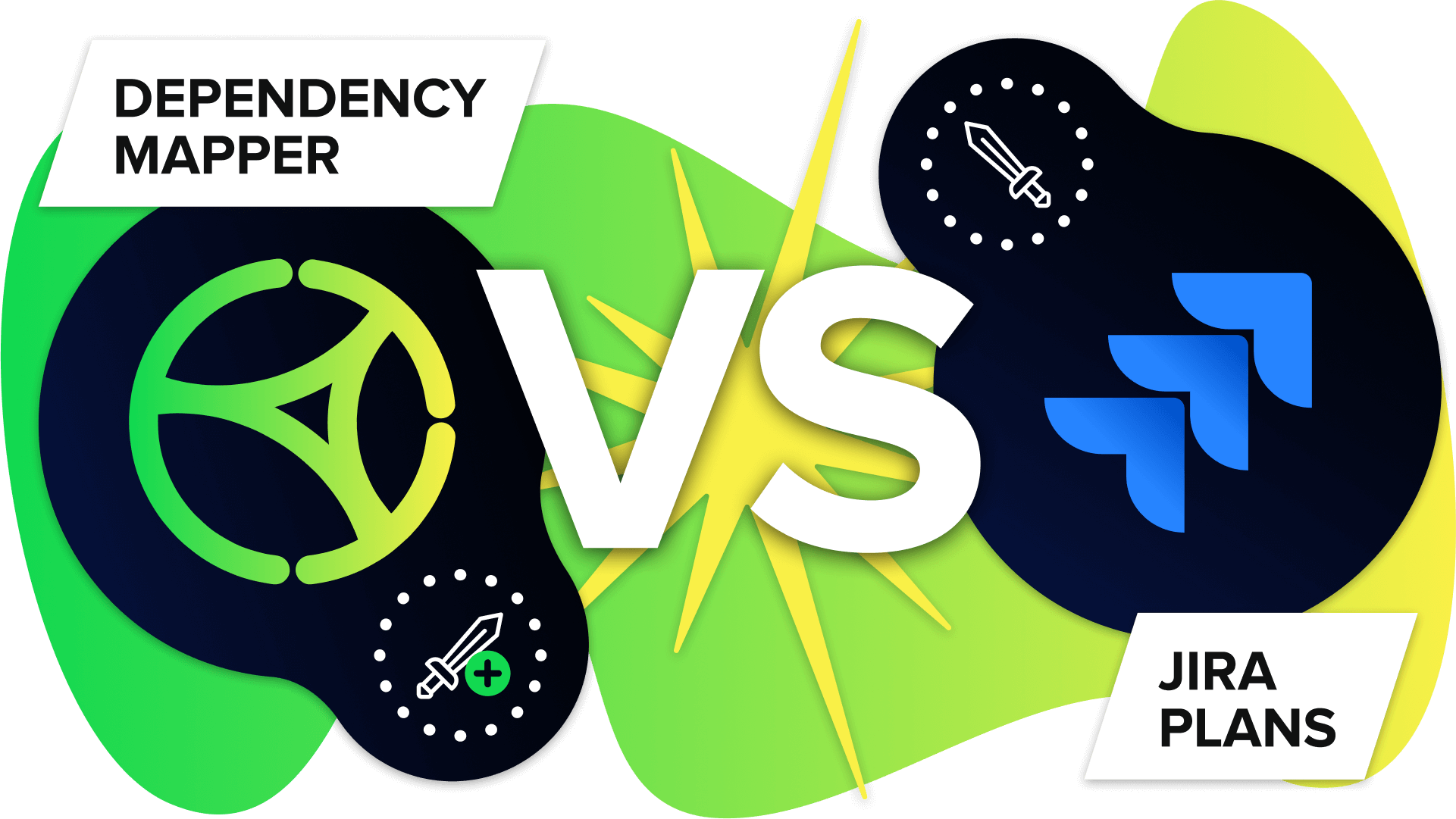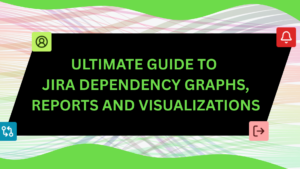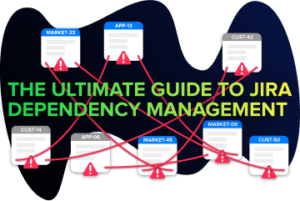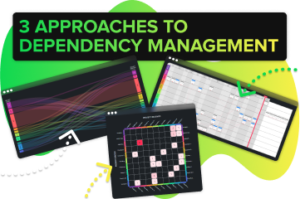
Dependencies in Jira tell you what work is reliant on other work being completed first. They allow you to see the order in which tasks need to be done, i.e. if there’s a dependency between two Jira issues, one must be finished before the next can begin. They also help with risk management in Jira by telling you which issues put the completion of others at risk if not attended to.
If you want to manage your Jira dependencies, then you might be considering either Dependency Mapper for Jira or Jira Plans. Both let you see and manage dependencies, but they’re also very different tools with different scopes and priorities. Let’s see which one is right for you.
Table of Contents
ToggleWhat is Dependency Mapper for Jira?
Dependency Mapper for Jira is, as it sounds, a dedicated tool for visualizing and managing dependencies. It enables users to understand their dependencies at a glance and manage them more efficiently.
When plugged into Jira, Dependency Mapper automatically visualizes the relationships between tasks, user stories, epics, and projects based on the way your Jira issues are linked. Instead of forcing you to make sense of cumbersome spreadsheets and complex diagrams, Dependency Mapper offers an intuitive bird’s eye or detailed view of dependencies in a variety of visual models: board, timeline, matrix, topology, network, individually, and more. This allows you to make reports to suit different stakeholders.
Armed with this data, users can identify critical paths, bottlenecks, and risks, and make well-informed decisions that keep their projects on track.
How does Dependency Mapper for Jira help with planning?
Companies use Dependency Mapper for Jira as a tool for two kinds of planning. The first is day-to-day planning by individual teams; Dependency Mapper helps them resolve dependencies in stories or epics and mitigate risk in their projects and sprints.
The second is Program Increment (PI) Planning or Big Room Planning by multiple teams. Big Room Planning was traditionally done in a literal ‘big room’ where all the teams, managers, and stakeholders came together to coordinate and collaborate towards a shared understanding of how they’d achieve certain business goals over the next quarter. In the more distributed work environment we now find ourselves in, Dependency Mapper allows you to run this process remotely through Jira. It allows users to answer questions like:
- Who and what are we dependent on to achieve a successful outcome, and who is dependent on us?
- Are we sequencing our work correctly?
- What are the largest sources of inbound and outbound work in our Jira?
With answers to these questions, teams can align on what needs to be done to achieve the business goals put forward.
What is Jira Plans?
Jira Plans, previously known as Advanced Roadmaps for Jira, is an advanced planning and roadmapping tool that comes with Jira Premium.
It lets you combine issues from boards, projects, and filters to create an all-encompassing plan in a customizable interface that spans multiple teams – or even your entire organization. A plan you can use to estimate release dates for cross-team projects, answer questions about resources, or map out your company’s annual goals.
Jira Plans lets you track dependencies across multiple teams and projects to get ahead of blockers. However, dependencies here are just a small part of a much larger whole. Jira Plans’ emphasis is on roadmapping and big-picture progress. It lets you account for dependencies when making plans, but dependencies aren’t its primary concern.
Does this mean Jira Plans is better than Dependency Mapper for Jira? Because it’s a broader tool that does more things? Let’s find out.
Jira Plans: Strengths
Jira Plans is a full-scale roadmapping tool that lets you roll up work to bigger goals with unlimited levels of hierarchy above an epic, and plan and track how you’re making progress on the big picture across multiple teams.
Jira Plans enables you to do forecasting by creating multiple versions of your roadmap to account for best and worst-case scenarios. It means you can compare different plans and what-ifs without affecting your live Jira data.
You can see multiple teams’ capacity on a sprint-by-sprint basis and make plans that take account of whether teams have bandwidth to complete the work they’ve scoped.
Jira Plans’ auto-scheduler will create a schedule of issues to be worked on based on priority, team capacity, issue estimates, dependencies, start and end release dates, sprint assignments, and other issue details.
Jira Plans: Weaknesses
One of the primary reasons users create plans in Jira Plans is because they want to understand and manage their dependencies. However, the dependency views in Jira Plans are basic and limited. You can choose to have dependencies displayed as badges or lines, and you can map the relationships between your issues in a single visualization in the dependencies report tab. This isn’t enough for most teams.
It is difficult to accurately capture dependencies in Jira Plans. By default, all dependencies in Plans are treated as though they have the “blocks” or “is blocked by” issue link type. You can use custom issue links but an administrator has to configure them. This is why many plans just utilize the default “blocks” dependency type, even though it doesn’t reflect the real nature of the dependencies and as such makes them harder to resolve.
The fact that a Jira admin has to configure any dependencies that aren’t “blocks” is extra work that could be avoided if Jira Plans was smarter and just automatically reflected your already established link types.
Senior managers and C-suite executives find Jira Plans difficult to navigate due to its complex slice-and-dice structure, unintuitive views, and too many configuration options in the back end. Teams often build so many custom views in Plans that there’s no consistency in what management sees and is expected to understand.
How Dependency Mapper wins
Dependencies are easier to resolve
Dependency Mapper for Jira automatically relies on the issue links you have already created in your Jira and is therefore able to reflect the nuanced relationships between your issues. This gives teams a better understanding of what their dependencies are, making it easier to resolve them.
Less administrative time
There is no default dependency type like there is in Jira Plans and no need to do any extra configuration to make the tool reflect the actual relationships between your issues.
It’s easier for senior management to understand the sequence and progress of work
Dependency Mapper for Jira comes with over 20 dependency charts and visualizations, which allow you to identify bottlenecks, check the sequence of work, see the path to dependency resolution, and more. The range of visualizations available makes it much easier to produce reports that stakeholders can understand, engage with, and make decisions on.
The focus on this one use case may be all you need
Dependency Mapper provides a much deeper and more accurate insight into your dependencies than Jira Plans because it is only concerned with this one use case. A lot of customers use Jira Plans because they want to plan and prioritize work based on dependencies. But if they want to do that, they may as well use a tool like Dependency Mapper, which does the job better.
Easy to use
Dependency Mapper was built to be accessible. Clicking a single button can give you an instant report, which you can fine-tune to get the specific views and insights you want later. There’s no additional configuration required for dependencies of all types to be displayed. You can also share your dependency charts really easily as Jira dashboard gadgets, or use the quickshare link feature, which just requires copy-pasting a string of text.
It’s way cheaper than Jira Plans
If you want to do planning based on dependencies, it’s $15,000 cheaper to do it with Dependency Mapper than Jira Plans. Jira Plans costs $16,000 USD per year based on a 100-seat instance, while Dependency Mapper costs $1,000 USD.
So which should you choose?
Jira Plans and Dependency Mapper for Jira have overlapping purposes and functions. Both tools facilitate planning, but Jira Plans’ emphasis is on roadmapping and Dependency Mapper’s emphasis is on managing and resolving dependencies.
The two tools complement each other in the sense that Jira Plans gives you the what (your roadmap of goals) and Dependency Mapper gives you the how (how to resolve dependencies to achieve your goals).
However, many teams find that they don’t need the full functionality of Jira Plans to decide on the sequence of their work. What they do need, however, is a proper understanding of who and what that work is dependent on. Something Jira Plans doesn’t do well enough, and Dependency Mapper does.
If you want to explore how you can manage all your Jira dependencies more easily and effectively, try Dependency Mapper for Jira free for a month.
And if you have any questions about how best to approach dependencies in your organisation, we’d love to hear from you.







